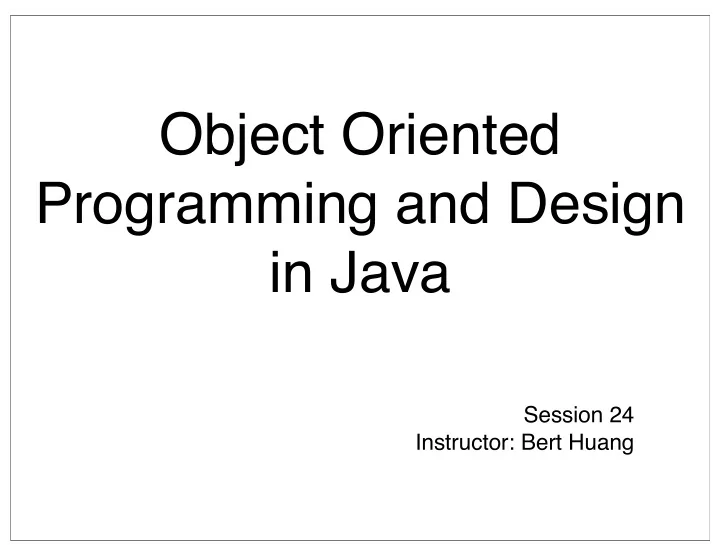

Object Oriented Programming and Design in Java Session 24 Instructor: Bert Huang
Announcements • Homework 4 solutions posted • Homework 5 due next class: Mon. May 3rd • Mon. May 3rd: Final review • Mon. May 10th, Final exam. 9 AM - noon • closed-book/notes, focus on post-midterm material, but material is inherently cumulative
Review • Multithreading with Conditions review (for the homework) • Multithreading in the chat program • Sending non-string data over the network • MVC over the network
Today ʼ s Plan • Recursion: Towers of Hanoi • Some thoughts on • COMS W1007, Object-oriented design in general, Computer science • Advice for future computer science study
Recursion • Recursion is self- reference • this is a self-reference • Methods can call themselves • Allows for elegant http://en.wikipedia.org/wiki/File:DrawingHands.jpg description of some computations
Silly Recursion Examples • GNU stands for GNU is Not Unix • • This sentence is not true.
Concepts in Recursion • Recursive routines (methods) solve a problem by calling themselves on subproblems • e.g., factorial(k) = k * factorial(k-1) • Recursive routines have a base case , which is an input for which no recursion is necessary • e.g., factorial(0) = 1
Towers of Hanoi • Three pegs, N discs fit on A B C pegs • discs are of different sizes • only smaller discs can be A B C placed on larger discs • Task: move all discs from one peg to another
Recursive Solution • solveHanoi(Peg start, Peg end, Peg Middle, int N) • S M E S M E Base case: move directly to end • Otherwise, • solveHanoi(start, middle, end, N-1) // move stack out of way • solveHanoi(start, end, middle, 1) // move bottom disc to end • solveHanoi(middle, start, end, N-1) // move stack onto bottom disc M E S S E S M E S M E M
Recursion • Provides elegant descriptions of algorithms • May not always be the most efficient implementation • Trade off between elegance and efficiency
Pre-Review Course Wrap-Up • Before the review, when we'll have tons of material to cover in a quick class session, we should reflect for a moment • Take a step back, look at big picture • What did we study? • What should we take away from this course?
Grades So Far 15 # of students 10 5 0 20 40 60 80 100 Projected Score • Histogram of grades so far (hw1-hw3 and midterm exam) • Average: 79 • there will be a scaling of scores
COMS W1007 • The second course for majors in computer science. • A rigorous treatment of object-oriented concepts • using Java as an example language. • Development of sound programming and design skills, problem solving and modeling of real world problems from science, engineering, and economics using the object-oriented paradigm.
Core Courses of CS@CU • 1004 Intro - a little programming, a little theory • 1007 OOP and Design - lots of programming • 3203 Discrete Math - lots of theory • 3137 Data Structures and Algorithms - lots of theory, a little programming • 3157 Advanced Programming - lots of programming
Object Oriented Design • will help tremendously in real applications (on the job, side projects), • will help with larger group projects, • will help a little with many programming assignments, • will probably waste your time on some small programming exercises.
Java as an Example Language • Java is a nice programming language that does a great job implementing object-oriented ideas • but it is not perfect • Java is also not the best language to learn because • too much is built in (e.g., data structures) • losing popularity in industry http://www.tiobe.com/index.php/content/paperinfo/tpci/index.html
What We Covered • Polymorphism • Programming style • Encapsulation • Classes and methods • Inheritance • UML diagrams • Design patterns • Programming by • contract: Frameworks preconditions, • Java graphics and postconditions and user interface invariants programming • Designing interfaces • Multithreading
Computer Science • Much of CS is just organized common sense • CS ideas pop up in real life • scheduling threads, scheduling work between collaborators, multitasking • “object-oriented” organization in everyday writing
Why Study CS? • It's fun to build things • CS is one of the few scientific and engineering disciplines where you can actually build the things you study • Lower-hanging fruit than many fields • The world needs computer scientists and engineers
Random Advice for Future Classes • Brush up on math • Start early • Write English (and code) clearly; • pay attention to details such as grammar, syntax, usage and spelling • Go to class and use office hours
The Final Stretch • Give Homework 5 your all, get help if you need it; plenty of office hours left • I'll post a sample final by Monday • Come to the review with questions • Don't let me and the TAs get away with not teaching you something
Recommend
More recommend